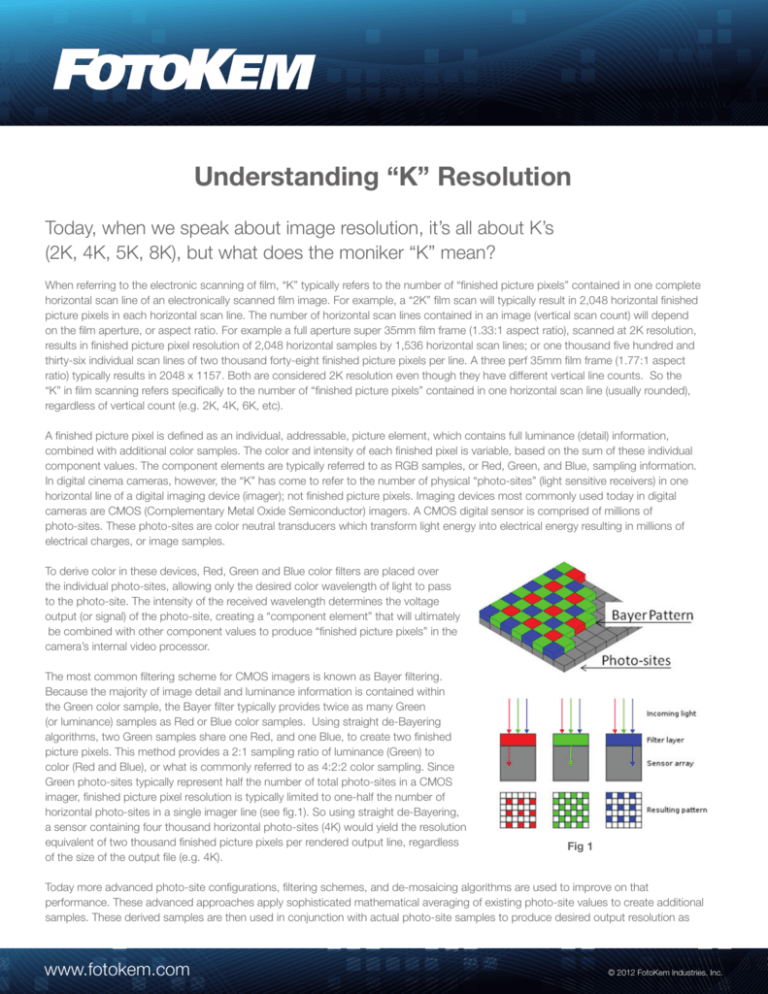Understanding “K” Resolution
advertisement

Understanding “K” Resolution Today, when we speak about image resolution, it’s all about K’s (2K, 4K, 5K, 8K), but what does the moniker “K” mean? When referring to the electronic scanning of film, “K” typically refers to the number of “finished picture pixels” contained in one complete horizontal scan line of an electronically scanned film image. For example, a “2K” film scan will typically result in 2,048 horizontal finished picture pixels in each horizontal scan line. The number of horizontal scan lines contained in an image (vertical scan count) will depend on the film aperture, or aspect ratio. For example a full aperture super 35mm film frame (1.33:1 aspect ratio), scanned at 2K resolution, results in finished picture pixel resolution of 2,048 horizontal samples by 1,536 horizontal scan lines; or one thousand five hundred and thirty-six individual scan lines of two thousand forty-eight finished picture pixels per line. A three perf 35mm film frame (1.77:1 aspect ratio) typically results in 2048 x 1157. Both are considered 2K resolution even though they have different vertical line counts. So the “K” in film scanning refers specifically to the number of “finished picture pixels” contained in one horizontal scan line (usually rounded), regardless of vertical count (e.g. 2K, 4K, 6K, etc). A finished picture pixel is defined as an individual, addressable, picture element, which contains full luminance (detail) information, combined with additional color samples. The color and intensity of each finished pixel is variable, based on the sum of these individual component values. The component elements are typically referred to as RGB samples, or Red, Green, and Blue, sampling information. In digital cinema cameras, however, the “K” has come to refer to the number of physical “photo-sites” (light sensitive receivers) in one horizontal line of a digital imaging device (imager); not finished picture pixels. Imaging devices most commonly used today in digital cameras are CMOS (Complementary Metal Oxide Semiconductor) imagers. A CMOS digital sensor is comprised of millions of photo-sites. These photo-sites are color neutral transducers which transform light energy into electrical energy resulting in millions of electrical charges, or image samples. To derive color in these devices, Red, Green and Blue color filters are placed over the individual photo-sites, allowing only the desired color wavelength of light to pass to the photo-site. The intensity of the received wavelength determines the voltage output (or signal) of the photo-site, creating a “component element” that will ultimately be combined with other component values to produce “finished picture pixels” in the camera’s internal video processor. The most common filtering scheme for CMOS imagers is known as Bayer filtering. Because the majority of image detail and luminance information is contained within the Green color sample, the Bayer filter typically provides twice as many Green (or luminance) samples as Red or Blue color samples. Using straight de-Bayering algorithms, two Green samples share one Red, and one Blue, to create two finished picture pixels. This method provides a 2:1 sampling ratio of luminance (Green) to color (Red and Blue), or what is commonly referred to as 4:2:2 color sampling. Since Green photo-sites typically represent half the number of total photo-sites in a CMOS imager, finished picture pixel resolution is typically limited to one-half the number of horizontal photo-sites in a single imager line (see fig.1). So using straight de-Bayering, a sensor containing four thousand horizontal photo-sites (4K) would yield the resolution equivalent of two thousand finished picture pixels per rendered output line, regardless of the size of the output file (e.g. 4K). Fig 1 Today more advanced photo-site configurations, filtering schemes, and de-mosaicing algorithms are used to improve on that performance. These advanced approaches apply sophisticated mathematical averaging of existing photo-site values to create additional samples. These derived samples are then used in conjunction with actual photo-site samples to produce desired output resolution as www.fotokem.com © 2012 FotoKem Industries, Inc. well as a quasi full bandwidth (4:4:4) color sample. Thus an imaging device that contains 4K horizontal photo-sites can mathematically derive 4K finished picture pixels per line in the rendered output image. Previous to the broad use of CMOS imagers, CCD (Charged Coupled Device) imagers were, and still are, widely used. These devices are highly efficient and do not require algorithms or double luminance sampling to create finished picture pixels. However CCD imagers do not have the light sensitivity of CMOS, thus limiting CCD’s practical application to HD resolutions. Examples of CCD camera 35mm and 2/3rds inch CCD imagers are represented in figures 2 and 3. The Panavision Genesis and Sony F35 cameras are the best examples of cameras using the 35mm CCD. These imagers provide 1920 x 1080 sample resolution (HD) in all colors (RGB), yielding full bandwidth (4:4:4) imaging, from a total photo-site count of 6.2 million photo-sites. Three chip cameras, such as Sony’s F23, F900, and Panasonic’s HPX3700 use prisms and dichroic filters to direct only Red, Green, or Blue light to three separate Red, Green, and Blue full resolution (1920x1080) imagers, who’s combined photo-site count also totals 6.2 million photo-sites. Manufacturers have moved away from CCD because CMOS imagers are cheaper to manufacture and because the increased sensitivity of CMOS enables manufacturers to create high volume (smaller, more sensitive, photo-site) imagers that enable full RGB 4K capture resolution, or equivalent or higher, derived output resolutions, with exposure latitudes closer to that of film. Fig 2 3 Chip CCD Full Resolution Color Sample So where does that leave 35mm film? The digital benchmark of 4K was established on the industry’s general acceptance that 35mm motion picture negative provides the equivalent pixel resolution of four Fig 3 thousand finished picture pixels per horizontal scan line (4K). With the industry now using digital cameras claiming 4K resolution it would appear that benchmark has been met. However to unequivocally answer the question of equality, objective testing is required. Scanning 35mm film negative at 8K resolution (two times oversample to ensure all information is captured) and objectively comparing that scanned image to a digitally acquired 4K file of the same objective reference materials (test charts) should answer the question. Below is an alphabetical list of digital cameras in common use today. Click on the information links for specific model and workflow information. Arri—Alexa, Alexa Plus, Alexa M, Alexa Studio: (CMOS) http://www.arri.com/mobile/apg/#home Red—Epic, Red One, Scarlet: (CMOS) http://en.wikipedia.org/wiki/Red_Digital_Cinema_Camera_Company Canon—EOS 300, 500, 5D III, 7D, 1 DC: (CMOS) http://www.usa.canon.com/cusa/professional/products/professional_cameras/cinema_eos_cameras Sony—F65, F55, F5, F3, FS700, FS100: (CMOS) http://pro.sony.com/bbsc/ssr/show-highend/resource.solutions Panasonic—Varicam–HPX3700: (CCD) http://www.panasonic.com/business/provideo/AJ-HPX3700.asp Vision Research—Phantom Series Cameras–Flex, Gold, 65: (CMOS) http://www.visionresearch.com/Products/High-Speed-Cameras/ www.fotokem.com © 2012 FotoKem Industries, Inc.







